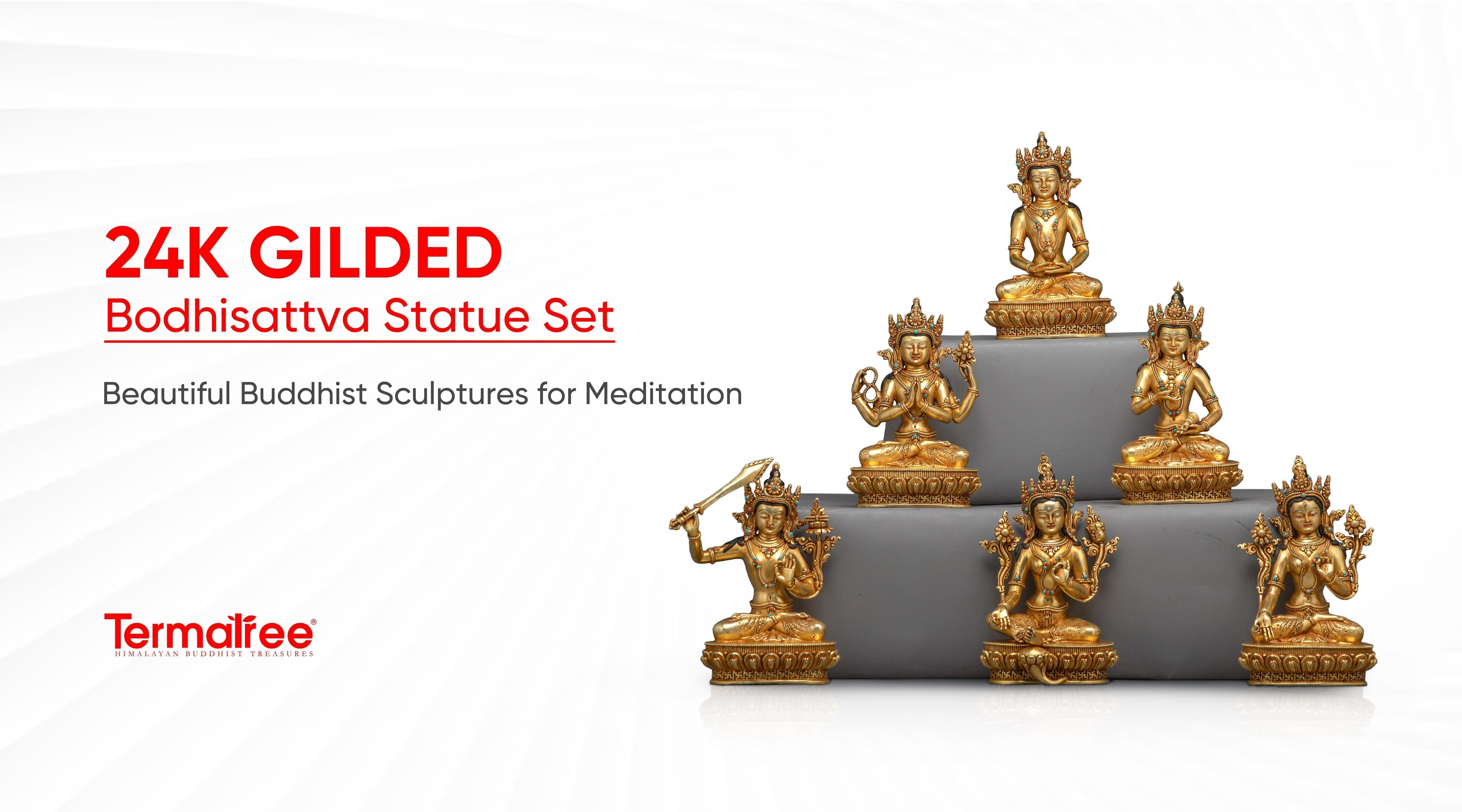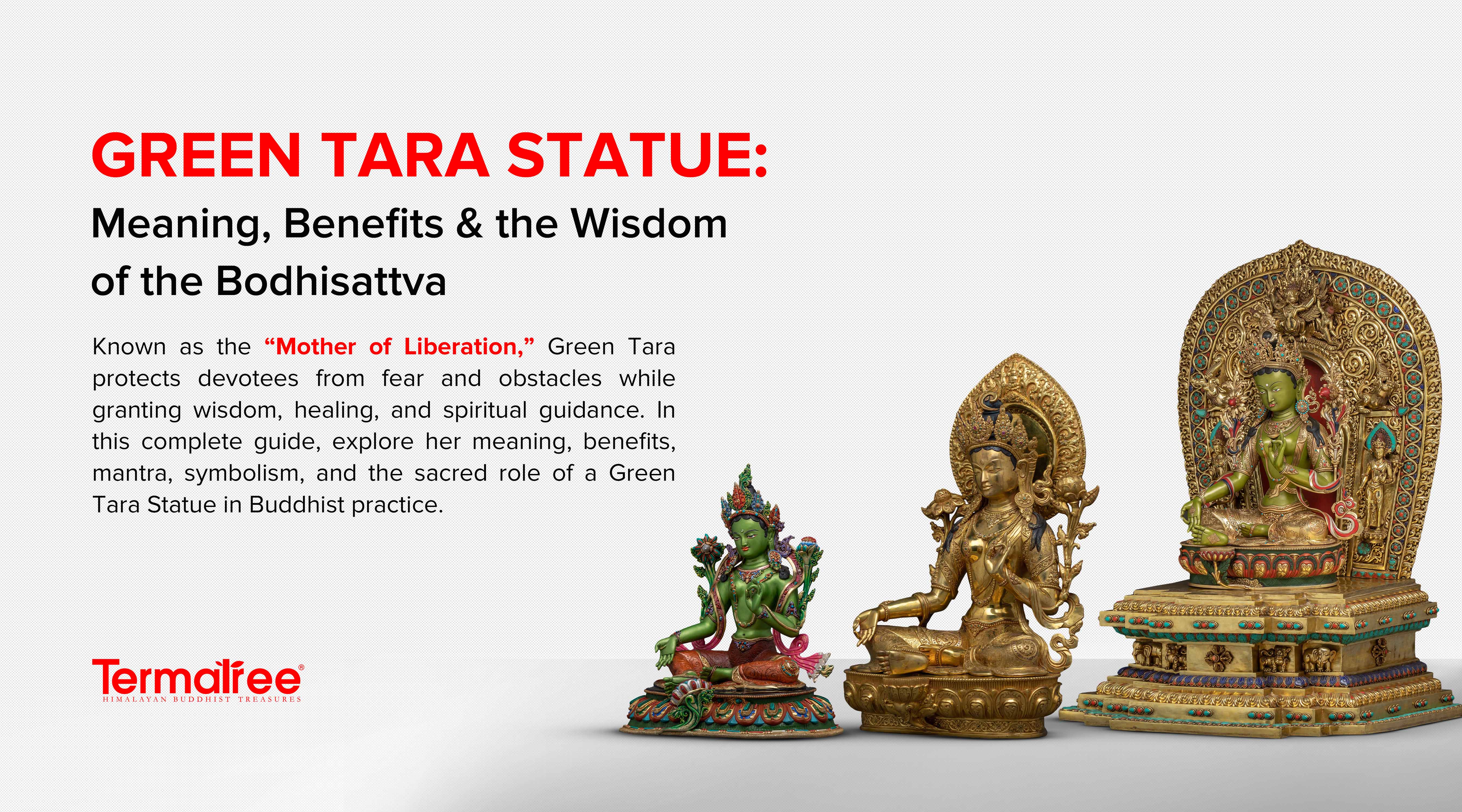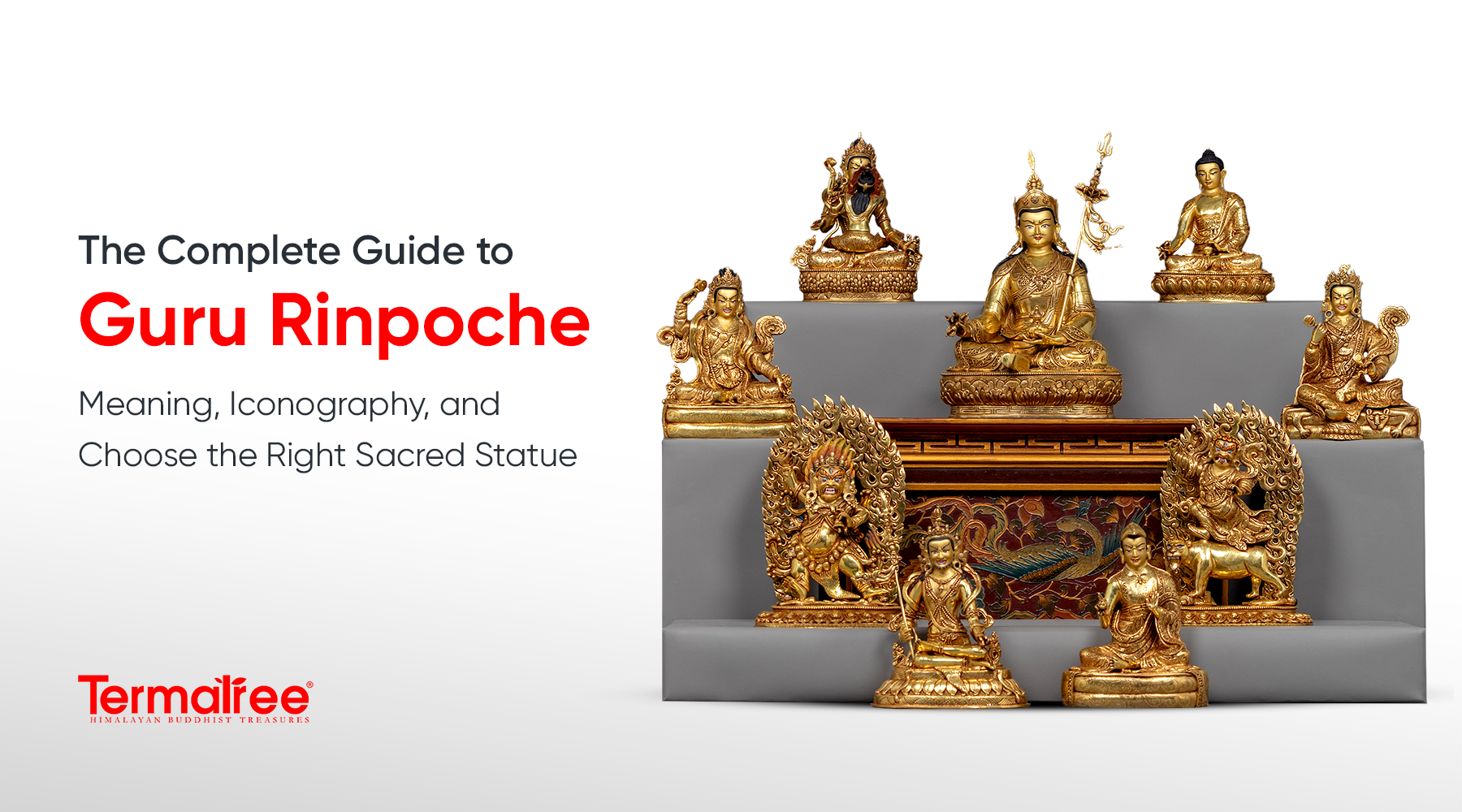Kuntu Zangpo and the Bodhisattva: Why Samantabhadra Is Not Just One Being
In the complex and nuanced world of Vajrayana cosmology, it is common to find figures with the same name who can have very different forms, roles, and philosophical meanings. One of the profound examples of this is Samantabhadra. The name references both the Primordial Buddha (Kuntu Zangpo in Tibetan) and the Bodhisattva of the Mahayana tradition, an important figure in the Mahayana tradition. Both figures share the same name, meaning "All-Good" or "Universal Virtue"; however, the two notions of Samantabhadra refer to two very different understandings of Buddhism.
In this blog, we will explore the iconography, symbolic meanings, soteriological roles, and doctrinal meanings of the two forms of this name in both Vajrayana and Mahayana Buddhism. By the end, you'll know why it is imprudent to confuse the Primordial Buddha with the Bodhisattva and how the differences indicate the spiritual depth of the Vajrayana tradition.
Understanding the Shared Name: "Samantabhadra"
Before we can discuss their differences, it's necessary first to delineate what the name "Samantabhadra" means. The Sanskrit term Samantabhadra means "all-pervasive goodness" or "universally virtuous." In this regard, the term highlights the qualities of infinite compassion, wisdom, and the inseparability of appearance and emptiness.
The name may remain the same; however, the uses and doctrinal contexts of each form are vastly different depending on whether we are talking about the Adibuddha (Primordial Buddha) or the Great Bodhisattva of Mahayana texts.
The Primordial Buddha Samantabhadra in Vajrayana Buddhism

Within Vajrayana Buddhism, particularly in the movement of Dzogchen and the lineage of Nyingma, Samantabhadra is classed as the Adibuddha or the Primordial Buddha. He is the first, the most primordial, the pure awareness that is formless, timeless, and non-dual that manifests all enlightened forms and phenomena. In Tibetan, he is called Kuntu Zangpo, and unlike other material forms and embodiments of Buddha, this Samantabhadra is not merely one of many Buddhas; he is the fountain and origin of all Buddhas.
He is the embodiment of Dharmakaya - the Truth Body or ultimate reality - which is the pure potential, the original unconditioned nature of mind. This form of Samantabhadra is beyond time and space, never forgets, never fails, and never departs from a state of absolute awareness.
Iconography and Representation
The iconography of the Primordial Buddha Samantabhadra is unique and has several discernible symbols:
-
Nude Form: He is usually depicted as naked, which symbolizes his formless essence and complete freedom from dualistic constructs and conceptual elaboration.
-
Embrace with Consort: He is often depicted hovering over a consort, Samantabhadri, in a yab-yum (sexual union) position, which depicts the unity of awareness (rigpa) and emptiness (shunyata), or compassion and wisdom.
-
Blue Color: He is a deep blue body, emphasizing the immensity and depths of both space and unchanging awareness.
-
No Ornaments or Attributes: He denotes himself and differentiates from many deities by signifying he has no ornaments or ritual objects, which reinforces that he is formless.
Role in Dzogchen and Vajrayana
Samantabhadra, as the Primordial Buddha, is at the heart of Dzogchen teachings. Samantabhadra is often referred to as the highest and most direct path of realization in the Nyingma tradition. He is not a deity to worship in a conventional manner, but to recognize as the authentic nature of one’s mind.
He is featured in some of the essential texts like the Kunjé Gyalpo (All-Creating King) and Dzogchen tantras, stating:
"From the beginning, I am Buddha. From the beginning, I am pure."
This phrase is at the basis of Dzogchen, that all beings are, in essence, Buddhas who are temporarily deluded.
Bodhisattva Samantabhadra in Mahayana and Vajrayana

Bodhisattva Samantabhadra is one of the Eight Great Bodhisattvas of Mahayana Buddhism, representing the embodiment of Buddha's activity, virtue, and vows. Samantabhadra is especially associated with practice, devotion, and the perfection of conduct.
He appears notably in Mahayana sutras such as the Avatamsaka Sutra (Flower Garland Sutra) and the Gandavyuha Sutra, and he often appears at the end of the practitioner's journey, encouraging practitioners to make great vows on behalf of all beings. He is an expression of limitless altruism and inspires practitioners to accomplish the most noble endeavors, particularly through the well-known Ten Great Vows of Samantabhadra, which include paying homage to all Buddhas, rejoicing in the virtues of others, and dedicating merits to all beings.
Iconography and Attributes
The Bodhisattva Samantabhadra has a rich and highly adorned iconographic form:
-
Seated on an Elephant: He is almost always depicted riding a white elephant with six tusks, representing the six paramitas (perfections) and the force of compassionate activity.
-
Graceful and Ornate: When we compare the naked Primordial Buddha, this bodhisattva, who wears ornaments, silken clothes, and sometimes a crown, indicating royal glory and magnificence.
-
Holding a Lotus or Sutra: He may hold a lotus, wish-fulfilling jewel, or a sutra, representing purity, wisdom, and dedication to the Dharma.
Role in Practice
Within East Asian Mahayana Buddhism (and among Chinese & Japanese traditions especially) this aspect of Samantabhadra is especially significant. He is also revered in the Vajrayana potential of the Tendai & Shingon schools in Japan. In a Vajrayana context, the Bodhisattva is invoked in aspirational practice, often at the end of teachings and rituals, where practitioners dedicate merit toward the enlightenment of all beings, very similar to his creaseless vows.
Key Differences Between the Two Samantabhadras
Even though we can see that they are linked by name and exist in multiple traditions of Buddhism, the Primordial Buddha Samantabhadra and the Bodhisattva Samantabhadra are intended for entirely different purposes. Ontological position, meaning, iconography, and scriptural references are just some of the many distinctions each serves in the immense cosmological and philosophical systems of Vajrayana & Mahayana. Let's examine these differences in greater detail.
Ontology and Practice
Primordial Samantabhadra symbolizes the unconditioned Dharmakaya, pure and timeless awareness that is beyond form, past, and future. He is not a separate existence, but the natural and luminous ground of all phenomena, an essential element of Dzogchen realization. The Bodhisattva, however, is a highly conscious being, one who is sort of an almost fully enlightened being within the world of samsara and out of a great vow and compassion, continues to be in the world so that he may guide other beings toward enlightenment and is as such an embodiment of the Bodhisattva ideal.
In terms of practice, the Primordial Buddha is recognized inwardly and not worshipped. Essentially, part of the Dzogchen practice is to rest in this awareness directly. The Bodhisattva, however, is worshipped through taking vows, the performance of ritual, and by emulating the Bodhisattva's behavior; the Bodhisattva provides a model to practitioners that is concerned with both devotion and ethics.
Iconography

|
Aspect |
Primordial Buddha Samantabhadra |
Bodhisattva Samantabhadra |
|
Clothing |
Naked, without garments |
Robed in princely attire and silk garments |
|
Adornments |
No ornaments or jewelry |
Wears elaborate crown and jewel ornaments |
|
Color |
Deep sky-blue body, symbolizing the infinite nature of awareness |
Usually shown in a golden or white hue, signifying virtue and purity |
|
Consort |
In union with Samantabhadri (yab-yum) |
Generally depicted alone |
|
Mount |
None |
Seated or riding a six-tusked white elephant |
|
Posture |
Often in meditative posture or embracing a consort |
Sitting or standing on an elephant in a dynamic, regal pose |
|
Attributes Held |
None—empty hands represent non-duality |
May hold a lotus, sutra scroll, wish-fulfilling jewel, or vajra |
|
Facial Expression |
Calm, serene, expressionless—beyond thought |
Gentle and benevolent, often smiling with a compassionate presence |
|
Setting/Environment |
Appears in a luminous, formless space or radiance |
Depicted in celestial or earthly paradises, surrounded by offerings |
|
Symbolic Meaning |
Embodiment of ultimate reality (Dharmakaya), unconditioned awareness |
Personification of virtuous conduct, vows, and enlightened activity |
Doctrinal Role
Primordial Samantabadra is the foundational figure of Tibetan Vajrayana, especially in Nyingma and Dzogchen, and represents the notion of the base or gzhi, the non-dual awareness in which all appearances arise and dissolve. He emanates all Buddhas, representing the spontaneous perfection or luminous clarity of the mind. His central teachings are meant to reveal the illusoriness of duality and the self-liberating nature of reality.
In contrast, the Bodhisattva is a foundational figure in Mahayana Buddhism, represented in two texts, the Avatamsaka Sutra and the Gandavyuha Sutra. He is considered the teacher of conduct and vows to lead aspirants onwards toward whole enlightenment period through the means of becoming the Bodhisattva as a service and virtuous way of living. The Bodhisattva's Ten Great Vows represent some of the most critical ethical texts in Mahayana and function as the foundation for endless liturgical and meditative engagements.
Cultural Presence
The two figures also differ substantially culturally and regionally. Primordial Samantabhadra is primarily found in Tibetan and especially high-level Dzogchen (Mdzod-snying) contexts. He is unknown in East Asian Mahayana and is almost exclusively Tibetan in iconography and philosophy. While he is clearly revered by essential figures such as Longchenpa and Jigme Lingpa, he suggests the notion of a cosmic principle, as opposed to a mythological character. His role appears highly esoteric and specialized.
Bodhisattva Samantabhadra is a household name across East Asia. In China, he partners well with Shakyamuni and Manjushri (as conduct, wisdom, and enlightenment, respectively) to conceptualize key aspects of bodhisattva practice, and is on an even keel with Mañjushri in the Chinese cultural context. He is Fugen Bosatsu in Japan, and appears in Shingon and Tendai temple contexts, among others. Aspects of his Vedic elephant mount, vows, and purification practices are part of regular monastic rites, ceremonies, pilgrimages, and lay devotion.
Scriptural Sources
Each form of the deity comes from a different school of scripture.
Primordial Samantabhadra is found in Vajrayana tantras, particularly in the Kunjé Gyalpo (All-Creating King), and in the Semde and Longde cycles of Dzogchen. These are texts that often come in the form of revealed texts or termas and are for those practitioners prepared to recognize the nature of mind and reality beyond the stipulated conceptual fabrication.
On the other hand, the Bodhisattva-based deity is located in Mahāyāna sutras, such as the Avatamsaka Sutra and the Samantabhadra Meditation Sutra. These are canonical texts, and the main thrust of these texts is to cultivate merit, purification, and practice in accordance with vows. These texts are found and referenced by lay practitioners as well as monks and nuns.
The Symbolic Importance of the Two Samantabhadras
The fact that there are two notable Samantabhadras is not a coincidence, but rather an important symbol that is part of the woven fabric of our Buddhist understanding. Their shared name connotes a fundamental level of oneness, as distinct beings, while acknowledging their particular functionality.

Primordial Buddha Samantabhadra reveals what we really are at the most fundamental state of being: pure, non-conceptually arising awareness, free from ignorance and karma. He is not standing out in front to be bowed to; he is the essence of our being, the luminous ground of being from which all Buddhas arise.
Bodhisattva Samantabhadra, on the other hand, reminds us what we have to do: take vows, cultivate merit, dedicate ourselves to the resolved welfare of others, and enact the Bodhisattva path. He is the thrust of altruistic momentum we require to actualize realization and to transform it into compassionate presence or activity.
They are the alpha and omega of the path: the timeless ground of awareness and the relentless enactment of enlightened behaviour. Just one is what is, while the other one is what becomes. They form the Kharya mandala of practice in which wisdom and compassion shake hands at every moment and embrace every condition.
Samantabhadra in Modern Practice
For modern Vajrayana students, it is important to distinguish between these two figures, not only to maintain doctrinal integrity but to maintain the continuity of the practitioner's practice. Although they share an identical name, their respective presence during meditation and ritual is of different lineage and purpose.
When one recites great aspiration prayers, like the King of Aspiration (Samantabhadra's Prayer), it is the Bodhisattva being invoked. His presence acts to bring forth an aspirational energy to engage practitioners to dedicate their virtue, cleanse their misdeeds, and generate a sincere dedication to benefiting others. These devotional practices, then, are adhered to ethical conduct and aspirational momentum.
On the other hand, when one is practicing Dzogchen contemplation, particularly when directly introduced to the nature of mind, it is the primordial Samantabhadra that is the focus. Here, it is not a practice of supplication, but rather of recognition; recognition of one's own awareness as already full, unbounded, and free.
Awareness of the embodied duality and practical distinction between these two Samantabhadras can aid practitioners who want to engage the Dharma with precision and fullness. In this way, the path becomes an integral conjoin of philosophical engagement and practice, realization and aspiration, where both emptiness and propagation of compassionate action illuminate the way.
Conclusion: Two Names, One Path to Awakening
While they bear the same name, Primordial Buddha Samantabhadra and Bodhisattva Samantabhadra represent very different functions within Vajrayana and Mahayana Buddhism. One represents the ground of being, the unborn and continuous source of all awareness; the other, the path of conduct, which allows beings to be guided by vows and compassionate action. The former is absolute, free of all dualities; the latter, relative, with action to engage the world through skillful means.
Still, the divergences form a perfect complement - with the recognition of Primordial buddha, we awaken to the mind's true nature—spontaneous, luminous, and free. In following Bodhisattva Samantabhadra, we engage in the activity of enlightenment, acting with ethical dedication and wisdom to benefit others.
In the end, these two forms are a reflection of the beginning and end of the Vajrayana path—a complete mandala where the source and goal are the same. Together they signify a path of non-dual realization—where pure awareness with compassionate action are not separate, they are entirely inseparable.




